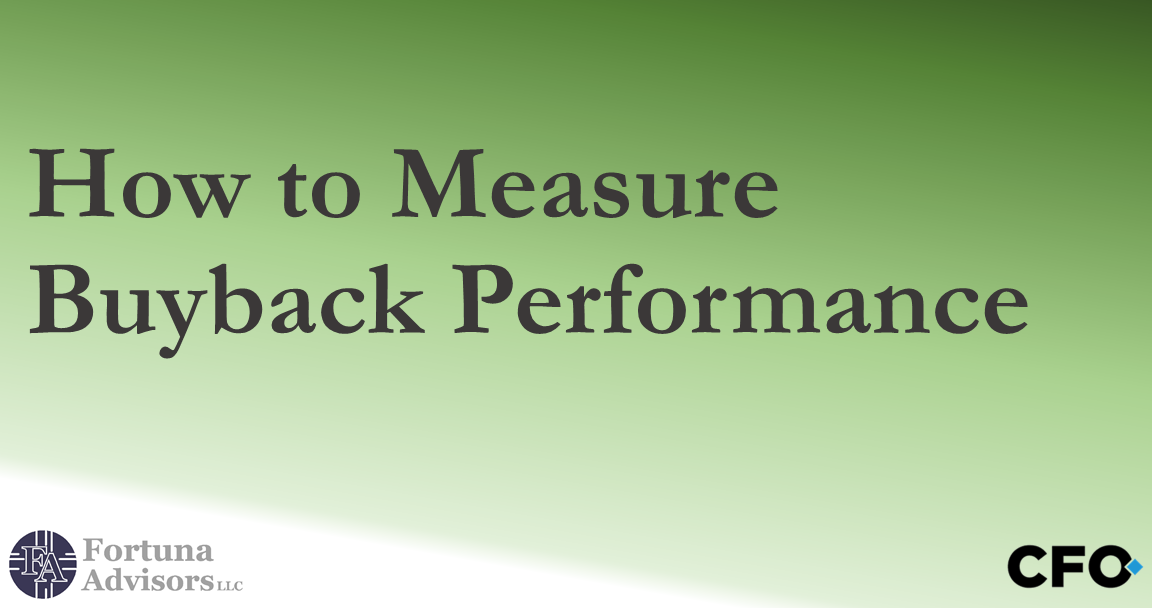Almost six years ago, we introduced Buyback ROI on CFO.com in an article titled, What’s Your Return on Buybacks. Buyback ROI is defined as a company’s annualized rate of return based on the cash spent on buybacks, the money saved by “avoiding dividends” on the repurchased shares, and the change in the stock price since the buyback.
Since that initial publication, Buyback ROI has been used by companies and investors to compare the return realized on buybacks to the returns earned on other uses of capital such as acquisitions and capital expenditures. It has become a useful tool in evaluating capital deployment effectiveness.
This week, Fortune published an article and ranking on this measure, utilizing information from our Buyback ROI Report 2017. At a time in which buybacks by S&P 500 companies continue to exceed $500 billion per year, the improved awareness and acceptance of Buyback ROI is encouraging.
However, we find that companies often struggle with translating the metric’s usefulness in evaluating the past to a forward-looking application. Buyback evaluation (or the lack thereof) is often disconnected from the rigorous analysis often associated with other forms of capital deployment. This disconnect likely reflects the common adoption of the pecking order theory that encourages a residual distribution policy. There are likely a few other motivations as well, but those can be saved for another article.
What’s the alternative? Until now, the best one could do was to suggest to execute buybacks in advance of share price increases. A higher future share price will help drive a higher ROI. But who doesn’t think their stock is cheap? Most managements believe their stock is undervalued and will rise in the future so we need a more rules-based process for evaluating buyback timing in order to deliver a desirable Buyback ROI.
We suggest that managers first perform a sanity check: (1) solve for the future earnings and multiple expansion scenario(s) necessary to deliver various levels of share price performance and subsequent Buyback ROI and (2) compare this performance to the past to get a sense of how likely it is that the company will achieve strong Buyback ROI.
To illustrate this exercise, consider IBM. If you assume the company maintains its current dividend yield of 3.8%, its share price would need to grow by 11.2% per year to achieve a 15% Buyback ROI (15%-3.8%, Buyback ROI incorporates the benefits of forgone dividends). This suggests a share price of $270 five years from now. IBM’s current share price is $159.
The consensus of the brokerage analysts that follow IBM is that it will deliver $13.60 of earnings per share over the next twelve months and 4% EPS growth over the long term. Compounding this growth rate until year five suggests a future EPS of about $15.88. The implied price-to-earnings multiple in year five would be the share price of $270 divided by the EPS $15.88, or 17.0x.
For IBM, a 17.0x multiple is higher than 96% percent of the historical observations over the last decade. The past is not always a good indicator of the future, but if IBM’s future valuations are at all like the past, this would suggest that buybacks are unlikely to deliver a 15% Buyback ROI at IBM.
There are other companies where there appears to be a better likelihood of achieving a strong future Buyback ROI. One such company is Southwest Airlines, which exhibits a relatively low current PE multiple, versus the company’s past, and a relatively strong consensus long-term EPS growth rate. To achieve a Buyback ROI of 15%, the implied year-five PE multiple is only at the 28th percentile against its past. It seems much more likely that Southwest can achieve a 15% Buyback ROI than IBM can.
Additional facets of the analysis can be added. For example, the analysis can also be done in reverse. Using IBM’s historical median PE multiple would imply a 9.3% Buyback ROI instead of the 15% that we solved for. A similar analysis for Southwest implies a Buyback ROI of 19.9% – more than twice that of IBM.
Variations of this exercise can be used to formulate a rules-based buyback framework that relies on a combination of important factors (company price multiples, earnings growth, probability of future multiple expansion, future cash needs and alternative uses, market valuations and trends, etc.). Such a framework will help increase the likelihood of a high buyback ROI by (1) providing a return-based focus for buybacks and (2) helping to improve timing.
These days, many executives say that investors put tremendous pressure on companies to buy back stock at all points in the market cycle. The approach described above can be used by managers to formulate and explain their capital deployment strategy. But it goes both ways. It can also be used by investors to apply more pressure when the timing seems advantageous and less when it doesn’t.

